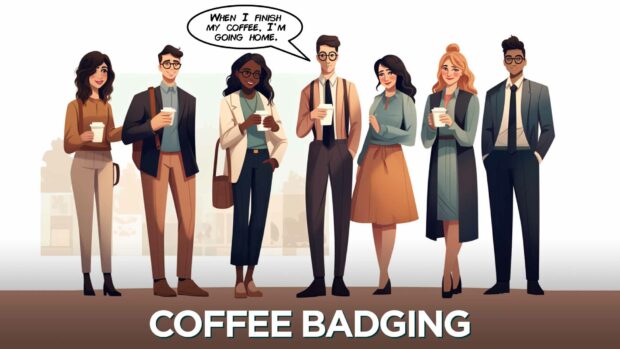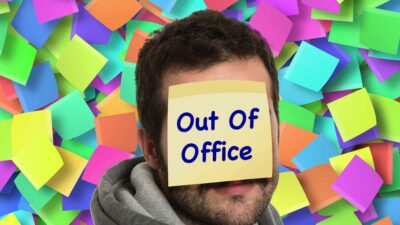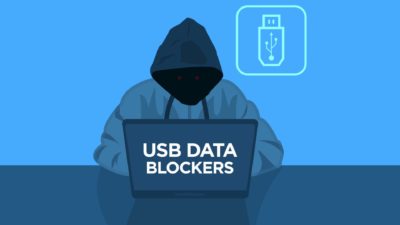Ding! Ding! That’s your morning alarm. Another day, another dollar. You drag yourself out of bed and go through the motions of getting ready for work. A quick shower, brushed teeth, and clean clothes later, you shuffle your way into the kitchen to make a thermos of coffee. The rich aroma wafts through the air as you pour it into your tumbler. You take a sip, savoring the comforting warmth. Just enough caffeine to get you going. Keys in hand, you head out the door.
Time for a little “coffee badging” at the office.
What is the coffee badging job trend sweeping workplaces nationwide? And why has it CEOs and managers so unnerved?
The Newest Weapon In The Push-Pull Office Power Struggle
After two years of making their own rules through remote work during COVID-19 restrictions, employees have gotten accustomed to enhanced flexibility and autonomy. Yet many companies still want workers back at their cubicles and desks for at least part of the workweek. So a subtle tug-of-war has emerged in some workplaces.
Enter “coffee badging,” the latest innovation in this power struggle. Employees amble into the office, grab a cup of joe in the breakroom, then promptly leave to finish their workday at home.
Crafty, slightly defiant, but oh so relatable. Who doesn’t want to stay snuggled under the covers, crank out spreadsheets in their pajamas, and nuke lunch leftovers in their own microwave? No commute, no office politics, no forced niceties with Gary from accounting.
Yet this mild protest concerns some managers. It signals shifting priorities between employers and staff. Both want the benefits without the sacrifices. But does coffee badging deserve the handwringing attention it’s garnered of late?
Why Employees Embrace The Subtle Rebellion
When considering coffee badging, it’s important to understand what motivates this behavior. Burned out and dissatisfied employees often use subtle signals to express their needs. Coffee badging allows them to gently push back against mandates they may disagree with or dislike.
Several key factors drive the trend:
Lingering COVID-19 Anxiety
While mask mandates have lifted, risks still remain. Infection rates fluctuate by region, new variants arise, and immunity wanes over time. Employees cite ongoing health worries as a top reason to limit office exposure. Remote work allows them to control their environment and reduce potential virus transmission.
Changing Assumptions About Productivity
Early pandemic concerns about remote work productivity loss failed to manifest in many industries. Tools emerged to track tasks, safeguard data, foster connectivity, and replicate office interactions virtually. With proof positive that collaboration, innovation, efficiency, and output can thrive remotely, assumptions have forever shifted.
Desire For Flexibility
Rigid 9 to 5 office life feels like a relic of the past to employees who’ve enjoyed setting their own hours and juggling personal and professional obligations from home. Coffee badging grants a modicum of control over their time while allowing managers to technically check the “mandatory office presence” box.
Concerns About Wellbeing
Long commutes, endless meetings, chatterbox coworkers, uncomfortable business attire, bland cafeteria food, and other office downsides affect emotional health and drain cognitive bandwidth. Coffee badging minimizes these stress triggers while allowing staff to maintain physical proximity bonds with colleagues, at least briefly.
How To Recognize Trouble Brewing

Unchecked coffee bagging can ripple through office culture, undermining positive dynamics between leadership and staff. Managers should remain vigilant for telltale signs of widespread discontent and plummeting engagement, such as:
- Sudden collective uptake of the trend
- Spiking remote working , sick days, and PTO
- Lackluster event attendance
- Falling productivity metrics
- Gossip and negative chatter
- Disengaged body language and attitudes
Proactive steps can get things percolating positively again. Savvy leaders view coffee badging as a clue, not a crisis — a chance to improve flexibility, transparency, work-life balance, and employee expectations around office policies.
Building Bridges Over Coffee And Zoom
With empathy and open communication, managers can convert coffee badging into an opportunity for growth. Some constructive responses include:
- Seeking direct input from employees through surveys, interviews, or focus groups to pinpoint sources of dissatisfaction
- Holding department meetings to collaboratively rework ineffective policies causing aggravation
- Compromising with hybrid arrangements like staggered office days to blend structure and autonomy
- Introducing recreational amenities into the office like gyms, nap rooms, and enhanced break areas
- Scheduling both virtual and in-person events to foster inclusion and social cohesion
- Offering benefits like telehealth services, mental health support, and wellness programs
- Providing the latest collaborative technology tools and optimized home office setups
- Tracking output rather than physical presence, focusing on results over appearances
With compassion and willingness to adapt on both sides, leaders and employees can compromise on arrangements that bridge personal preferences with company goals. A dash of courageous communication also goes a long way.
Is The Coffee Badging Job Just Trend A Fad?
As workplaces continue calibrating post-pandemic operations, coffee badging likely persists as a mild protest for those called back against their wishes. Think of it like a type of “quiet quitting“. But with attentive leadership and empathetic dialogue, camaraderie can percolate again.
Perhaps over time, the trend loses steam and fades. But key positives will hopefully remain: ruthlessly prioritizing flexibility, championing balance, and cherishing employees as humans first.
The takeaway? That cup of coffee shared between colleagues means more than mere caffeine. It signifies coming together and connecting. And that rich shared experience matters more than minutes logged at a desk.























 4 Cute Holiday Dress Ideas – What To Wear To A Holiday Party
4 Cute Holiday Dress Ideas – What To Wear To A Holiday Party
Leave a Reply
You must be logged in to post a comment.